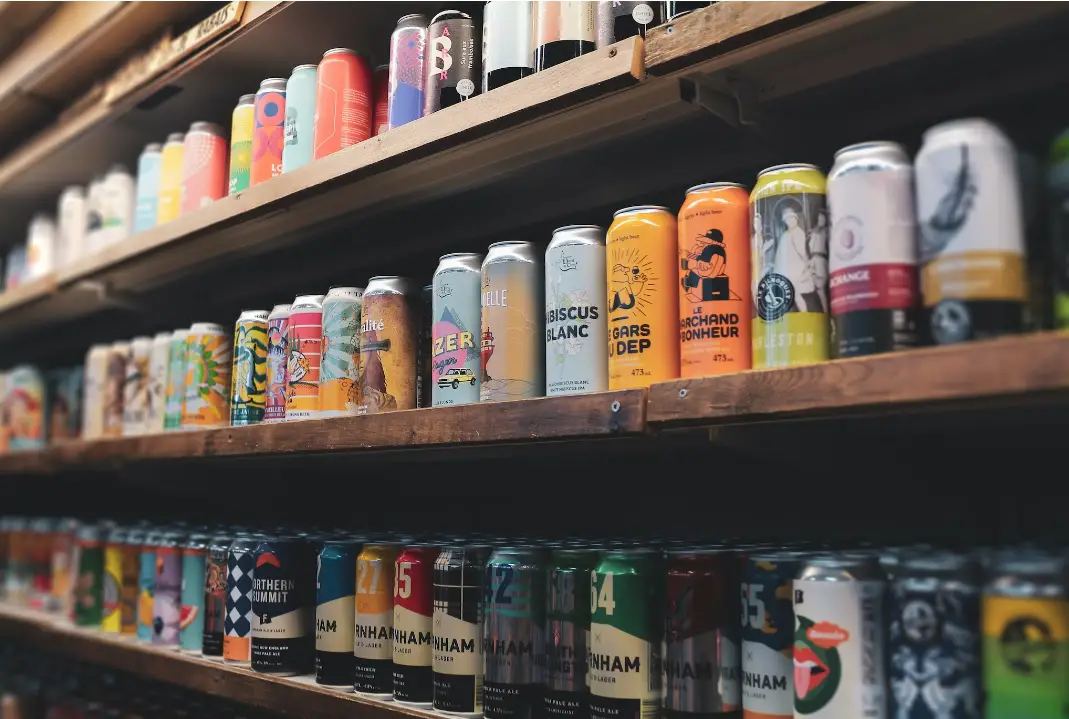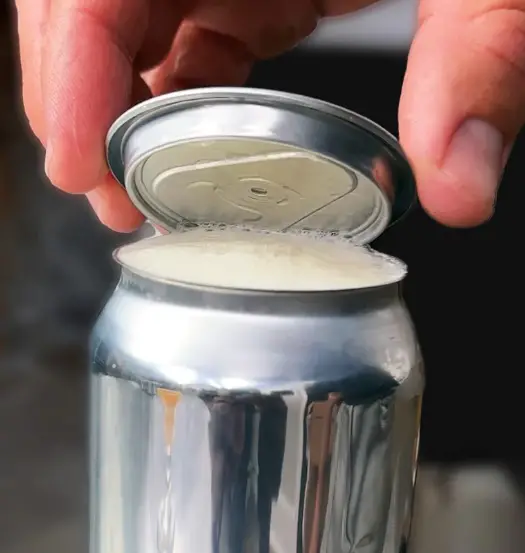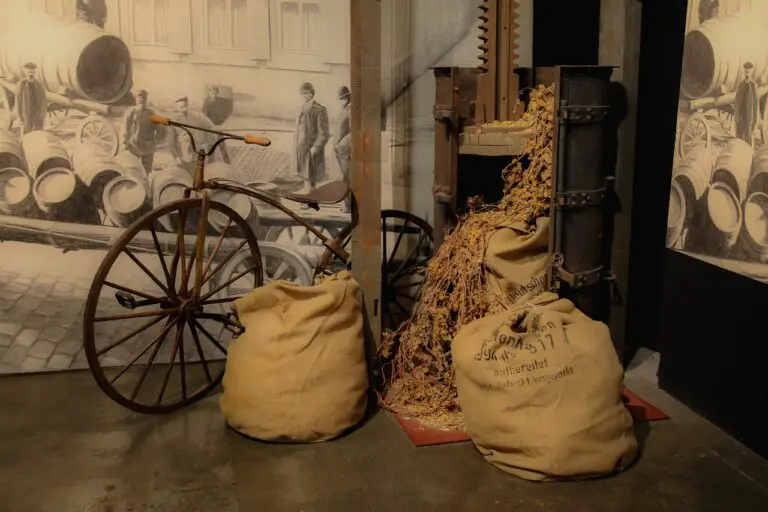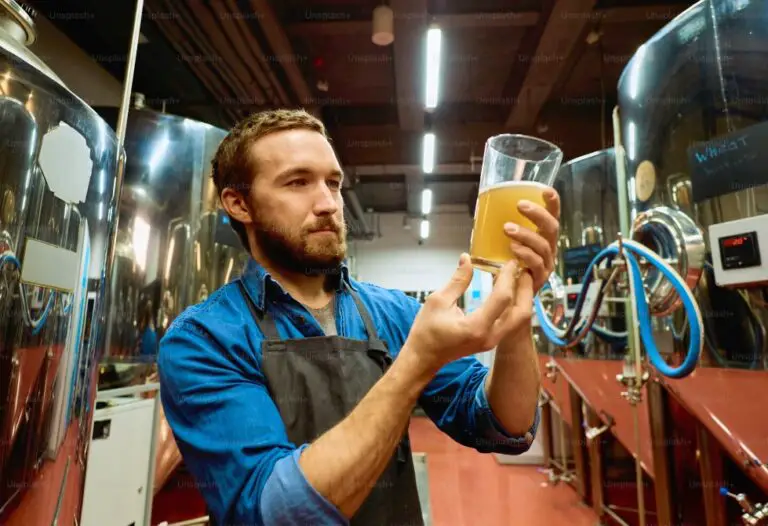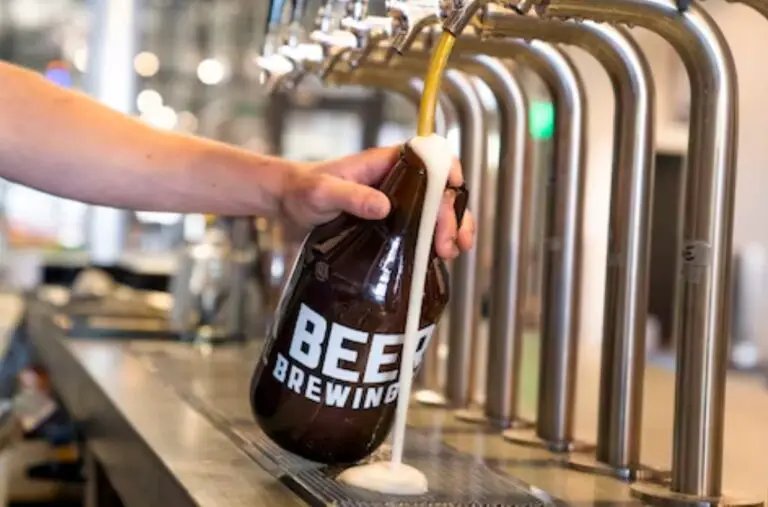What Are Beer Bottles Made Of?
Beer bottles, or more precisely, beer containers, let’s talk about them.
What are beer bottles made of? Let’s take a look…
Beer bottles are commonly made from three primary materials: glass, plastic, and aluminum (of course, you can find other weird beer containers, like some that are made of paper, wood, or… whatever you can imagine). Glass bottles crafted from a mixture of silica, soda ash, and limestone, have long been favored for preserving the taste and quality of beer. They undergo a meticulous manufacturing process involving melting, forming, and annealing.
On the other hand, plastic beer bottles, typically composed of PET or HDPE, offer lightweight and portable alternatives. However, concerns exist regarding their environmental impact and recycling challenges. Aluminum beer cans, made from refined bauxite and alloyed for strength, provide a lightweight and readily recyclable option with the added benefit of rapid cooling.
As sustainability gains importance, there’s a growing exploration of alternative materials, such as biodegradable options and innovative paper-based packaging, reflecting a broader shift towards more eco-friendly beer packaging solutions.
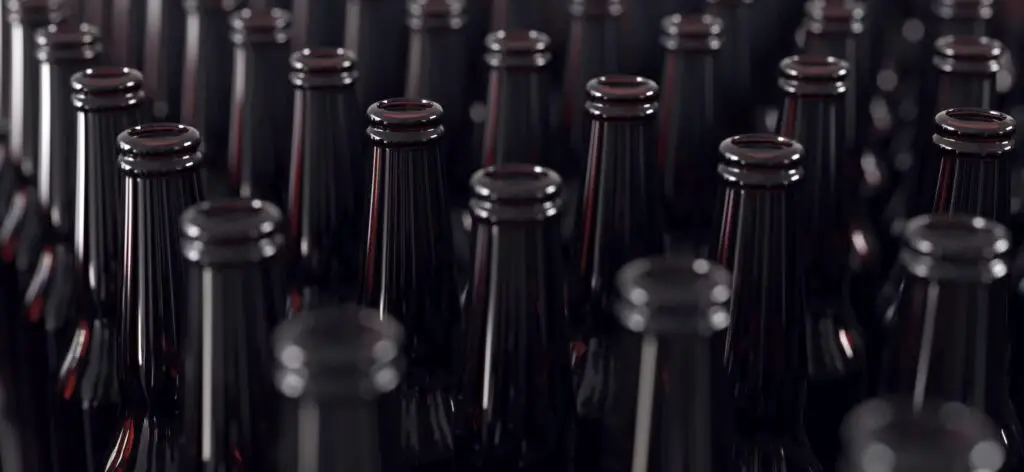
Glass Beer Bottles
The Composition of Glass
Glass beer bottles primarily comprise a few key raw materials that undergo a precise manufacturing process. The primary components of glass include silica (sand), soda ash (sodium carbonate), and limestone (calcium carbonate).
Silica is the main structural element, providing the glass with clarity and strength. Soda ash helps reduce the silica’s melting point, making it more malleable during the manufacturing process. Limestone, acting as a stabilizer, contributes to the overall durability of the glass. Other components, such as alumina, are sometimes added to enhance the glass’s resistance to temperature variations.
The glass manufacturing process involves heating these raw materials to high temperatures, typically around 1700 degrees Celsius, to form a molten glass that can then be shaped into bottles. This careful combination of raw materials and precise manufacturing ensures that glass beer bottles maintain the desired properties for preserving the flavor and quality of the beer inside.

The Manufacturing of Glass
The manufacturing of glass beer bottles is a meticulous process that involves several distinct stages to ensure the final product meets quality standards.
- Melting: The process begins with the melting of raw materials, including silica, soda ash, limestone, and potentially other additives, in a furnace. The high temperatures, typically around 1700 degrees Celsius, cause the materials to melt and form molten glass. This molten glass is then carefully monitored to ensure it reaches the desired consistency and purity.
- Forming: Once the glass is molten, it is shaped into the familiar bottle form through one of two primary methods: blowing or pressing. In the blowing method, a gob of molten glass is gathered on the end of a hollow tube and shaped into a parison, which is then blown into the final bottle shape using compressed air. Alternatively, molten glass is pressed into a mold to achieve the desired bottle shape in the pressing method.
- Annealing (Cooling): After the glass bottle is formed, it goes through an annealing process to relieve internal stresses and enhance its strength. The bottles are gradually cooled in a controlled environment, typically within a lehr or annealing oven. This controlled cooling prevents the glass from becoming brittle and ensures uniform thickness and strength throughout the bottle.
- Quality Control: Quality control is integral to the glass manufacturing process. Automated systems and skilled technicians inspect the bottles for defects, ensuring they meet specific thickness, shape, and clarity standards. Any bottles with imperfections are identified and removed from the production line. This meticulous quality control helps guarantee that the glass beer bottles look appealing and maintain their structural integrity during transportation, storage, and use.
The Advantages of Glass Beer Bottles
Glass beer bottles enjoy widespread popularity due to several advantages contributing to the overall drinking experience and environmental considerations.
- Preservation of Taste and Quality: Glass is inert and impermeable, so it does not interact chemically with the beer. This property helps in preserving the beer’s flavor and quality over time. Unlike some other materials, glass does not impart any unwanted odors or tastes to the beverage, ensuring that the consumer experiences the beer as the brewer intended.
- UV Protection: Glass provides excellent protection against ultraviolet (UV) light, which can be detrimental to the stability of beer. Exposure to UV light can lead to a phenomenon known as “skunking,” where the beer develops a foul odor and flavor. Glass acts as a barrier, preventing UV rays from reaching the beer and safeguarding its integrity.
- Recyclability: Glass is highly recyclable, and the recycling process does not compromise its quality. Recycled glass, or cullet, can be used to produce new bottles without a loss in quality. This recyclability contributes to the sustainability of glass packaging.
- Sustainability: Glass is considered an environmentally friendly packaging option. It is made from abundant raw materials such as sand, and the recycling process requires less energy than new glass production. Choosing glass beer bottles aligns with sustainability efforts, especially when consumers actively participate in recycling programs.
- Aesthetic Appeal: Glass beer bottles are often associated with a premium and traditional image. The transparent nature of the glass allows consumers to appreciate the color and clarity of the beer. Additionally, glass offers opportunities for creative labeling and branding, enhancing the overall visual appeal of the product.
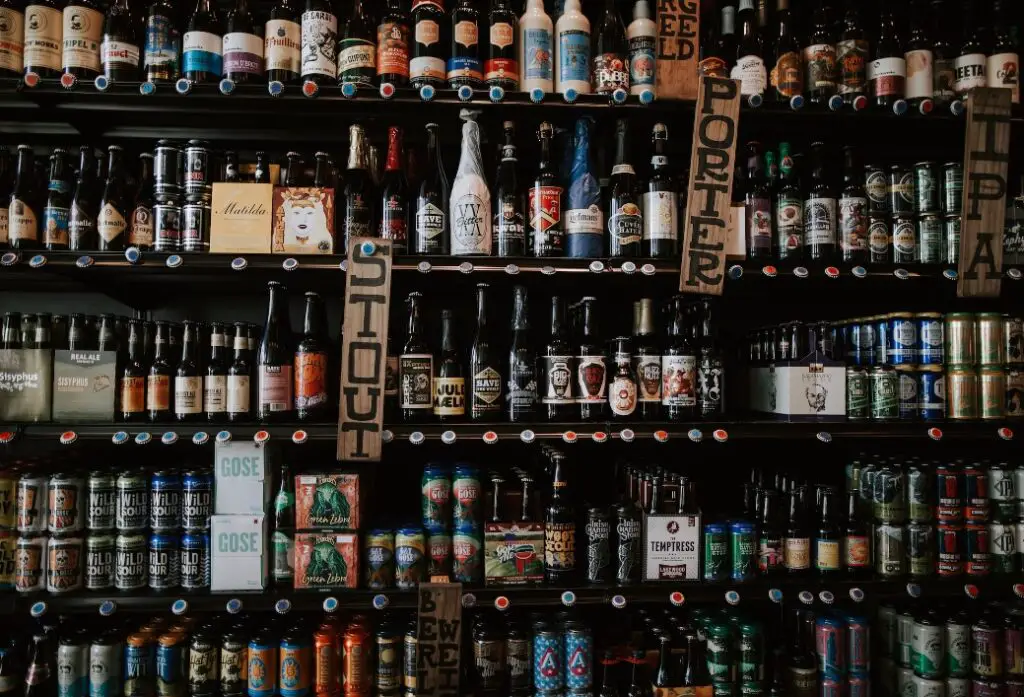
Plastic Beer Bottles
Types of Plastic Beer Bottles
Plastic beer bottles predominantly come in two primary types: PET (Polyethylene Terephthalate) and HDPE (High-Density Polyethylene). Each type of plastic has distinct characteristics, making them suitable for different applications in the beverage industry.
PET (Polyethylene Terephthalate) Bottles:
- Material Characteristics: PET is a lightweight, transparent, and durable plastic. It is known for its clarity, allowing consumers to see the bottle’s contents clearly. PET is also resistant to oxygen and carbon dioxide permeation, which helps maintain the beer’s freshness.
- Manufacturing Process: PET bottles are formed through a process called injection stretch blow molding. This involves injecting melted PET into a mold and stretching and blowing the material into the desired bottle shape.
- Advantages: PET bottles are lightweight, making them convenient for transportation and handling. They are also shatter-resistant, reducing the risk of breakage during use or transit.
HDPE (High-Density Polyethylene) Bottles:
- Material Characteristics: HDPE is a sturdy and opaque plastic known for its high strength and chemical resistance. It is less transparent than PET, and its opaque nature provides protection against light, which can be beneficial for light-sensitive beverages.
- Manufacturing Process: HDPE bottles are typically produced through a process called extrusion blow molding. This involves melting the plastic and then shaping it by blowing air into a mold.
- Advantages: HDPE bottles are known for their durability and resistance to impact. They are also recyclable, contributing to environmental sustainability. The opaque nature of HDPE provides protection against light, which can be beneficial for beverages that are sensitive to UV exposure.
Differences:
- Transparency: PET is transparent, allowing consumers to see the content clearly, while HDPE is opaque, protecting light.
- Weight: PET is lighter than HDPE, making it a preferred choice for products that require a lightweight packaging solution.
- Applications: PET is commonly used for beverages, including beer, due to its transparency and oxygen barrier properties. HDPE, with its sturdiness and opacity, is often used for products where protection from light is crucial.
The Pros and Cons of Plastic Beer Bottles
Plastic beer bottles come with a set of advantages and disadvantages, impacting factors such as convenience, sustainability, and environmental impact.
Pros:
- Plastic beer bottles, especially PET ones, are significantly lighter than glass bottles. This lightness lowers transportation costs and makes plastic bottles more convenient for consumers.
- Plastics, particularly PET and HDPE, are known for their durability and resistance to breakage. This makes plastic beer bottles less prone to damage during transportation, handling, or accidental drops.
- Plastic bottles offer greater design flexibility, allowing for various shapes and sizes. This flexibility provides beverage companies with creative options for branding and packaging.
- The lighter weight of plastic bottles compared to glass reduces the carbon footprint associated with transportation. Lower transportation costs can contribute to overall sustainability efforts.
Cons:
- Plastic beer bottles contribute to environmental pollution, especially if not properly disposed of. Plastic waste can take a long time to decompose, leading to concerns about its impact on ecosystems.
- While plastic is recyclable, recycling rates for plastic bottles can be lower than desired. Contamination, sorting issues, and insufficient recycling infrastructure contribute to challenges in achieving high recycling rates.
- Plastic is permeable to oxygen and carbon dioxide, which can affect beverages’ freshness and shelf life. This can be a concern for products like beer, where maintaining specific qualities is crucial.
- Some consumers associate plastic with lower-quality packaging compared to glass. This perception may impact the perceived quality of the beer, even if the plastic used is of high quality.
- The production of plastic materials involves the use of fossil fuels, contributing to greenhouse gas emissions. While plastic production has become more efficient, it still has an environmental impact compared to certain alternatives.

Aluminum Beer Cans
Aluminum Production:
Aluminum is derived from bauxite ore through a refining process called the Bayer process. The ore is first crushed, and then alumina is extracted through a series of chemical reactions. The Hall-Héroult process follows, using electrolysis to separate aluminum from alumina, producing aluminum metal.
Aluminum Alloys and Durability:
Aluminum used in beer cans is often alloyed with other elements to enhance its properties. Common alloys include 3004 and 5052, which balance strength, formability, and corrosion resistance well. The durability of aluminum is a key factor in its popularity for beverage packaging, as it helps protect the contents from external elements.
Manufacturing Process:
- The first step in manufacturing aluminum beer cans involves rolling. Aluminum sheets, typically in coil form, are fed through rolling mills. This process reduces the thickness of the aluminum while increasing its length.
- The rolled aluminum sheets are then cut into circles, serving as the cans’ tops and bottoms (ends). The body of the can is formed through a deep-drawing process where the aluminum sheet is drawn into the familiar cylindrical shape of the can.
- The interior of the aluminum can undergo a coating process. A thin layer of a polymer is applied to prevent any interaction between the aluminum and the beverage, preserving the taste and quality of the drink. This coating also helps protect the aluminum from corrosion caused by the beverage’s acidity.
- Aluminum beer cans are printed with labels, branding, and other information. This is typically done through a combination of offset printing and lithography. The cans may also undergo additional decorating processes, such as embossing or debossing, to enhance the visual appeal.
Advantages of Aluminum Beer Cans:
- Aluminum is exceptionally lightweight, contributing to the portability and convenience of beer cans. This makes them a popular choice for on-the-go consumers and outdoor events.
- Aluminum has high thermal conductivity, meaning it cools rapidly. This property allows beverages in aluminum cans to reach optimal drinking temperature quickly.
- Aluminum provides excellent protection from light, preventing UV rays from affecting the beer. This is particularly advantageous for light-sensitive beverages.
- Aluminum is highly recyclable, and the recycling process requires significantly less energy than new aluminum production. The recyclability of aluminum contributes to the circular economy and environmental sustainability.

New Materials in Beer Bottling
Biodegradable Materials
- One notable trend in beer packaging is the exploration of biodegradable materials. Breweries are increasingly looking for alternatives to traditional packaging materials that can break down naturally, reducing environmental impact. Biodegradable plastics made from plant-based sources or other renewable materials are being developed as a more sustainable option.
Paper-Based Beer Packaging
- Paper-based packaging is gaining traction as a more eco-friendly alternative. Brewers are exploring the use of paperboard and carton packaging for beer. These materials are renewable, recyclable, and often biodegradable. Additionally, advancements in paper-based packaging technology are improving their ability to withstand the unique requirements of beer storage.
Bioplastics
- Bioplastics, derived from renewable resources such as corn, sugarcane, or potatoes, are considered a more sustainable beer packaging option. These materials can be compostable or recyclable, presenting a promising alternative to conventional plastics. Innovations in bioplastic technology are addressing issues related to strength, flexibility, and barrier properties required for beer packaging.
Circulary Economy Initiatives
- Breweries are increasingly adopting circular economy principles in their packaging strategies. This involves designing packaging to be easily recyclable, using recycled materials and actively participating in recycling programs. This holistic approach aims to minimize waste and promote a closed-loop system.
Smart Packaging
- Smart packaging solutions integrate technology to enhance consumer engagement and provide information about the product. QR codes, augmented reality labels, and interactive packaging are being explored to offer consumers details about the beer, brewing process, and even suggested food pairings.
Lightweighting and Minimalist Design
- Lightweighting involves reducing the weight of packaging materials, leading to decreased material usage and transportation-related emissions. Additionally, minimalist design trends aim to reduce excess packaging and emphasize simplicity. These approaches align with sustainability goals and cater to environmentally conscious consumers.
Hybrid Beer Packaging
- Hybrid packaging solutions combine different materials to leverage the strengths of each. For example, combining paper and plastic or incorporating recycled materials into traditional packaging structures. These innovative combinations aim to improve sustainability while maintaining the necessary properties for beer storage.
Reusable Beer Packaging
- Reusable packaging models, such as refillable growlers and kegs, are gaining popularity. Breweries and consumers are embracing the concept of reducing single-use packaging by encouraging the return and reuse of containers, contributing to a more sustainable approach.
Wrapping It Up
In conclusion, beer bottles are as diverse as the brews they contain. From the timeless charm of glass to the convenience of plastic and the sustainability of aluminum, each material brings its unique qualities to the table. Whether you’re sipping from a crisp glass bottle, a lightweight plastic container or a cool aluminum can, the choice of beer packaging material is a blend of tradition, innovation, and environmental consciousness.

I am a young architect with a passion that goes beyond blueprints… it’s beer! undertherosebrewing.com is more than just a blog, it’s a manifestation of my lifelong dream to explore, read, and learn everything about beer. Join the blog on this unfiltered and genuine adventure into the heart of beer culture. Cheers!
